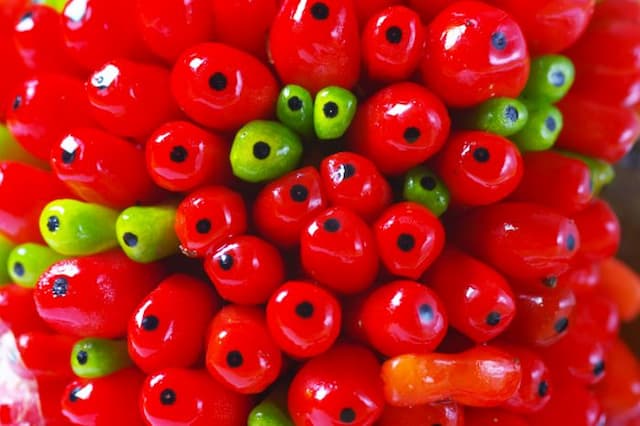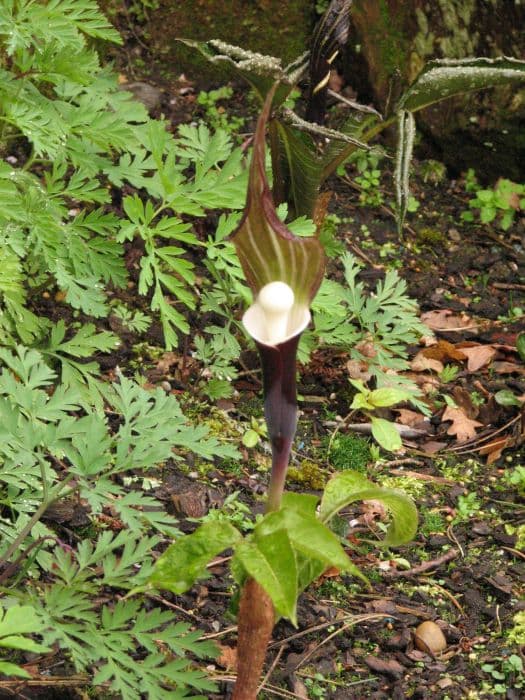Calla Lily 'Pink Puppy' Zantedeschia 'Pink Puppy' (PBR)

ABOUT
The 'Pink Puppy' is a captivating plant characterized by its unique and eye-catching flowers. These blossoms are distinctive, with a funnel-shaped spathe that resembles a lush, flaring skirt. The spathe color is a soft yet vivid pink hue that can brighten any space. Inside this attractive shield, there's a spadix, a finger-like spike that stands straight, providing a striking contrast with its yellowish tone against the pink. This plant's leaves are also noteworthy; they are broad, glossy, and deep green, forming an elegant backdrop that further accentuates the vibrant pink flowers. The leaves emerge on long stems that arise directly from the plant's base, creating a seemingly tropical appearance. The 'Pink Puppy' can create a statement with its charming blooms and contributes to an exotic flair in gardens or indoor spaces. It's a low-maintenance choice that requires minimal effort but offers maximum decorative impact.
About this plant
 Names
NamesFamily
Araceae
Synonyms
Calla Lily, Arum Lily, Pink Calla Lily
Common names
Zantedeschia 'Pink Puppy' (PBR).
 Toxicity
ToxicityTo humans
Calla Lily 'Pink Puppy' contains insoluble calcium oxalates which can be toxic if ingested. The symptoms of poisoning typically include a burning sensation in the mouth and throat, swelling of the lips, tongue, and throat, difficulty swallowing, and possible nausea, vomiting, and diarrhea. In severe cases, the swelling can interfere with breathing, posing a significant risk.
To pets
Calla Lily 'Pink Puppy' is also toxic to pets due to the insoluble calcium oxalates it contains. If ingested by an animal, it can cause symptoms such as oral irritation, intense burning, and irritation of the mouth, tongue, and lips, excessive drooling, vomiting, and difficulty swallowing. In severe cases, it can lead to dehydration, an increase in heart rate, or difficulty breathing, which would necessitate immediate veterinary attention.
 Characteristics
CharacteristicsLife cycle
Perennials
Foliage type
Deciduous
Color of leaves
Green
Flower color
Pink
Height
1-2ft (30-60cm)
Spread
1-2ft (30-60cm)
Plant type
Herb
Hardiness zones
8
Native area
South Africa
Benefits
 General Benefits
General Benefits- Aesthetic Appeal: Zantedeschia 'Pink Puppy', commonly known as calla lily, adds a splash of color with its vibrant pink flowers, enhancing the beauty of gardens and living spaces.
- Easy to Grow: Calla lilies are relatively easy to care for, which makes them suitable for gardeners of all levels of experience.
- Cut Flower Use: The blooms of the calla lily are long-lasting when cut, making them perfect for bouquets and floral arrangements.
- Compact Size: The 'Pink Puppy' variety has a compact growth habit, making it ideal for smaller gardens, borders, or as a potted plant indoors or on patios.
- Seasonal Interest: Blooming in the spring and summer, calla lilies provide seasonal interest and can be used for seasonal decorations and themes.
- Drought Tolerance: Once established, calla lilies can tolerate periods of drought, making them suitable for xeriscaping and low-water gardens.
 Medical Properties
Medical PropertiesThis plant is not used for medical purposes.
 Air-purifying Qualities
Air-purifying QualitiesThis plant is not specifically known for air purifying qualities.
 Other Uses
Other Uses- Photography Prop: The Pink Calla Lily's vibrant color and unique shape make it a popular choice for photographers looking to add a splash of color and elegance to floral or garden-themed photo shoots.
- Art Inspiration: Its striking form and vivid hues can inspire artists, serving as a subject for paintings, drawings, and other visual arts, encouraging the depiction of its aesthetic in various mediums.
- Fashion and Design: The Pink Calla Lily's color and shape can influence fashion designers and interior decorators, who may replicate its form in textiles, patterns, and accessories.
- Teaching Botany: These plants can be used in educational settings to help students learn about plant biology, hybridization, and horticulture through direct observation.
- Holiday Decorations: It can be used in crafting unique and vibrant holiday wreath arrangements or table centerpieces for special occasions like Easter or Mother's Day.
- Wedding Motifs: Pink Calla Lilies are a popular choice for wedding decorations and themes, including bouquets, centerpieces, and venue adornments for a romantic and luxurious atmosphere.
- Culinary Presentation: While not edible, Pink Calla Lilies can be used as a non-toxic decoration to embellish plating presentations in high-end culinary settings.
- Themed Parties: For events with a floral or garden theme, Pink Calla Lilies can serve as the focal point in decorations, invitations, and even cakes adorned with safe, non-toxic fondant replicas.
- Grief Counseling Tool: The flower's serene beauty may be used symbolically in grief counseling settings as a means of providing comfort and signifying sympathy.
- Handcrafted Jewelry: The Pink Calla Lily can inspire jewelry designs; for instance, artisans can create earrings, necklaces, or brooches based on its elegant shape and color.
Interesting Facts
 Feng Shui
Feng ShuiThe Calla Lily is not used in Feng Shui practice.
 Zodiac Sign Compitability
Zodiac Sign CompitabilityThe Calla Lily is not used in astrology practice.
 Plant Symbolism
Plant Symbolism- Beauty - The elegant shape and vibrant hue of the Calla Lily symbolize exquisite beauty.
- Purity - Because of its clean, sleek lines, the Calla Lily is often associated with purity and innocence.
- Femininity - The soft pink color of 'Pink Puppy' represents grace and femininity, making it a popular choice for celebrating womanhood.
- Passion - While white Calla Lilies are traditional symbols of purity, the pink version indicates a passionate nature.
- Rebirth - In many cultures, lilies are associated with rebirth and renewal, due to their perennial nature and ability to bloom again each season.
- Transformation - The flower's growth from a bulb to an elegant flowering plant symbolizes hope and the possibility of positive change.
 Water
WaterFor Calla Lilies, including the 'Pink Puppy' variety, it's important to keep the soil consistently moist during the growing season. Water the plant thoroughly when the top inch of soil feels dry to the touch, which could be once or twice a week, depending on the climate and indoor conditions. During their dormant period in winter, reduce watering to prevent rot. An estimated amount could be about 1 gallon of water every week during active growth, but always adjust based on the plant's response and environmental factors.
 Light
LightCalla Lilies like the 'Pink Puppy' thrive in bright, indirect light. They can tolerate some direct morning sun, but too much direct sunlight can scorch their leaves. A north- or east-facing window is ideal, offering plenty of light without the intensity of midday sun. In very hot climates, they will appreciate some shading during the brightest part of the day.
 Temperature
TemperatureCalla Lilies, including 'Pink Puppy', prefer temperatures between 60 to 75 degrees Fahrenheit during active growth. They can survive in temperatures as low as 50 degrees but should not be subjected to frost conditions. Conversely, they can tolerate up to 80 degrees but may need increased watering in higher temperatures.
 Pruning
PruningPruning a 'Pink Puppy' Calla Lily is vital to remove spent flowers and encourage more blooms. Cut back the flower stalks as close to the base as possible after the flowers fade. Pruning is recommended throughout the blooming season to keep the plant tidy and healthy. The best time to conduct a more thorough pruning is after the foliage has died back, usually in late autumn.
 Cleaning
CleaningAs needed
 Soil
SoilCalla Lily 'Pink Puppy' thrives best in a well-draining potting mix, composed of two parts peat moss, one part perlite, and one part loamy soil to ensure proper drainage and root aeration. The ideal soil pH for Calla Lilies should be between 5.6 and 6.5.
 Repotting
RepottingCalla Lily 'Pink Puppy' should be repotted every two to three years or when it becomes root-bound. This is typically when you see roots emerging from the drainage holes or when the growth starts to slow down due to restricted space.
 Humidity & Misting
Humidity & MistingCalla Lily 'Pink Puppy' prefers a humidity level of around 60%. To maintain this, you may use a humidifier or place the plant in a naturally humid environment, such as a bathroom, as long as it gets enough light.
 Suitable locations
Suitable locationsIndoor
Place in bright, indirect light, and avoid dry air.
Outdoor
Needs partial shade, and shelter from strong winds.
Hardiness zone
8-10 USDA
 Life cycle
Life cycleCalla Lily 'Pink Puppy' begins its life as a rhizome, a type of underground stem that stores energy for the plant. When conditions are favorable, typically in spring, the rhizome sprouts shoots that develop into leaves and a single flower spike enclosed in a spathe, the distinctive feature of Calla Lilies. The plant enters a vegetative growth phase where it focuses on leaf growth and the accumulation of nutrients through photosynthesis. Following the vegetative phase, it progresses to the flowering stage, where the spathe unfolds revealing the spadix covered in tiny flowers, which can attract pollinators if grown outdoors. After flowering, the plant sets seed if pollination occurs, but it is often propagated by dividing the rhizomes. Finally, the Calla Lily 'Pink Puppy' enters a dormancy period in response to decreasing temperatures and reduced daylight in the fall or early winter, which is particularly important for the rhizome to conserve energy for the next growing season.
 Propogation
PropogationPropogation time
Spring-Early Summer
The Zantedeschia 'Pink Puppy', commonly known as the Pink Calla Lily, is typically propagated through division, which is considered the most popular method for this plant. This process is usually undertaken in late winter or early spring, just before the new growing season begins. To propagate by division, gardeners carefully lift the rhizomes from the soil after the foliage has died back. They then divide the rhizomes into smaller sections, ensuring that each division has at least one growth bud. The divided rhizomes are then replanted at a depth of about 3 to 4 inches (7.6 to 10.2 cm) into well-draining soil, maintaining proper spacing to allow for growth. Adequate watering helps establish the divided plants, and if conditions are ideal, these new plants will bud and bloom within the same growing season.









